When it comes to creating a truly distinctive flooring option that merges natural beauty with modern durability, few choices match the visual impact of a log epoxy floor. This innovative flooring solution has captured the attention of homeowners, designers, and business owners who want to bring the warmth of natural wood into their spaces while maintaining the practical benefits of epoxy resin. After working with various flooring materials over the years, I’ve found that this particular combination offers something truly special for those willing to invest in quality craftsmanship.
What Makes Log Epoxy Floors Special
A log epoxy floor consists of wood log slices or cross sections embedded in clear or tinted epoxy resin, creating a seamless surface that showcases the natural grain patterns and character of the wood. Each installation becomes a unique work of art because no two pieces of wood are identical. The growth rings, knots, color variations, and natural imperfections in the wood create visual interest that simply cannot be replicated with synthetic materials.
The epoxy component serves multiple purposes beyond just holding the wood pieces in place. It provides a glass-like finish that protects the wood from moisture, prevents warping, and creates an incredibly durable walking surface. The resin fills all gaps between log sections and can be customized with various colors, metallic pigments, or even kept crystal clear to showcase the wood’s natural beauty.
Understanding the Design Possibilities
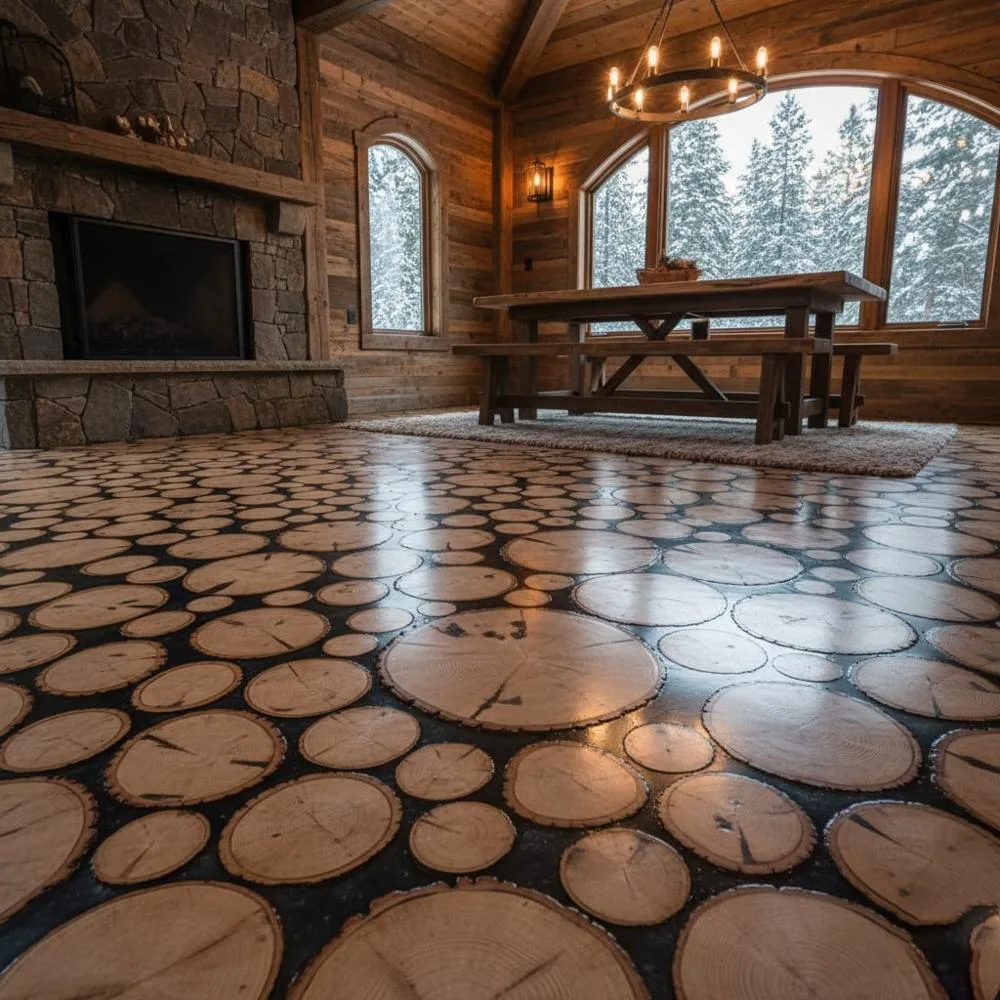
One of the most exciting aspects of planning a log epoxy floor is the sheer range of design possibilities available. You can choose from different wood species, each bringing its own color palette and grain characteristics. Oak offers classic beauty with prominent grain patterns, while cedar provides aromatic qualities and natural resistance to decay. Pine creates a lighter, more casual aesthetic, and exotic hardwoods like teak or mahogany deliver rich, dark tones that exude luxury.
The arrangement of log slices also dramatically impacts the final appearance. Some installations feature tightly packed sections with minimal epoxy showing between pieces, creating an almost entirely wooden appearance. Others space the logs further apart, allowing the epoxy to become a prominent design element. The epoxy itself can remain clear to showcase the wood, or you can tint it with colors that complement or contrast with the wood tones.
Creating Patterns and Visual Flow
Beyond simply laying log slices randomly, skilled installers can create intentional patterns that guide the eye through a space. Gradient effects using logs of varying sizes create movement, while alternating wood species in stripes or geometric patterns adds structured visual interest. Some designers incorporate logs of dramatically different diameters, mixing large rounds with smaller branch sections to create organic, forest floor inspired designs.
The Installation Process Explained
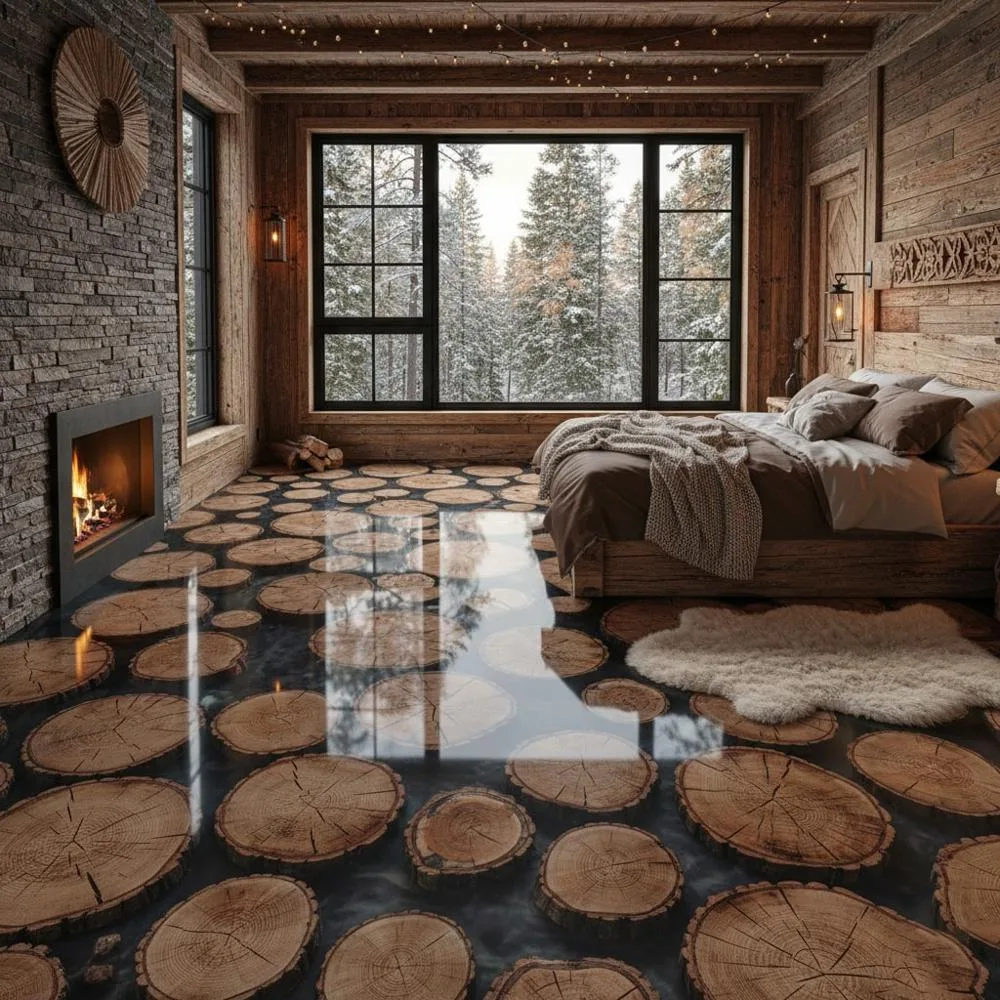
Installing a log epoxy floor requires careful planning and execution. The process typically begins with proper substrate preparation, which is absolutely critical for long term success. The concrete or plywood subfloor must be level, clean, and completely dry. Any moisture in the substrate can cause problems with epoxy adhesion and potentially lead to coating failure.
Wood preparation represents another crucial phase. Log slices need proper drying to reach the correct moisture content, typically between six and eight percent. Using wood that’s too wet can cause shrinkage after installation, creating gaps between the wood and epoxy. Many professionals kiln dry their log slices or allow them to air dry for several months before installation.
The actual installation involves several steps. First, a primer coat of epoxy is applied to the prepared substrate, creating a sealed base layer. Then, log slices are carefully positioned according to the planned design. This stage requires artistic vision combined with practical considerations about fit and spacing. Once all wood pieces are placed, the flood coat of epoxy is poured over the entire surface, filling all gaps and covering the logs completely.
Curing and Finishing Touches
After pouring, the epoxy needs adequate time to cure properly. Initial hardening occurs within 24 to 48 hours, but full cure typically takes seven days or longer depending on temperature and humidity conditions. During this time, the floor cannot be walked on or subjected to any stress. Once fully cured, the surface may receive additional clear coats for enhanced depth and protection, followed by a final buffing to achieve the desired sheen level.
Cost Considerations and Budgeting
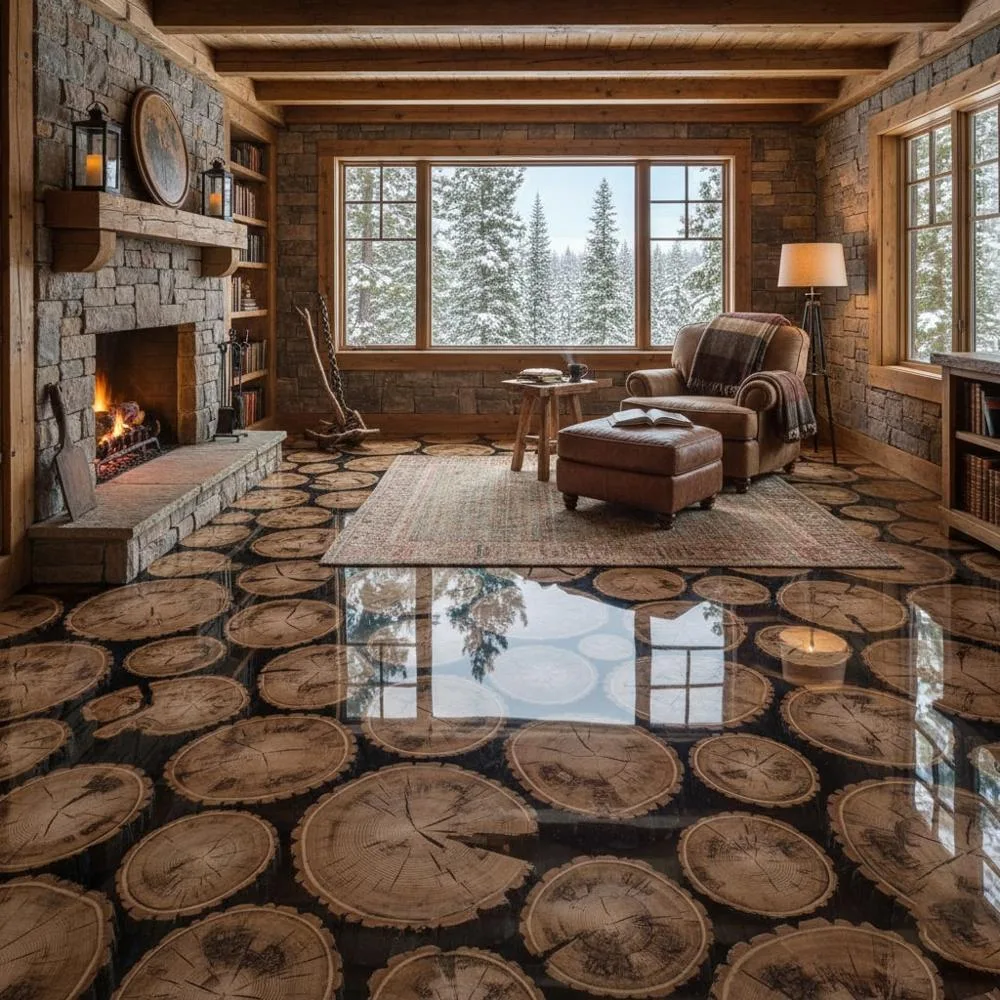
A log epoxy floor represents a significant investment compared to conventional flooring options. Material costs vary based on wood species selection, epoxy quality, and the project’s square footage. Professional installation adds considerable expense due to the labor intensive nature of the work and the specialized skills required.
For a typical residential installation, expect costs to range from $15 to $30 per square foot for materials alone. Professional installation can double or triple this figure, bringing total costs to $45 to $90 per square foot or more for premium installations. While these numbers may seem high compared to laminate or basic hardwood, the completely custom nature and durability of a log epoxy floor justifies the investment for many property owners.
Several factors influence the final price. Complex patterns requiring extensive wood cutting and fitting increase labor costs. Rare or exotic wood species command premium prices. Large format rooms actually become more economical per square foot than small spaces because setup costs are distributed over more area. Geographic location also matters, as labor rates and material availability vary significantly by region.
Maintenance Requirements and Long Term Care
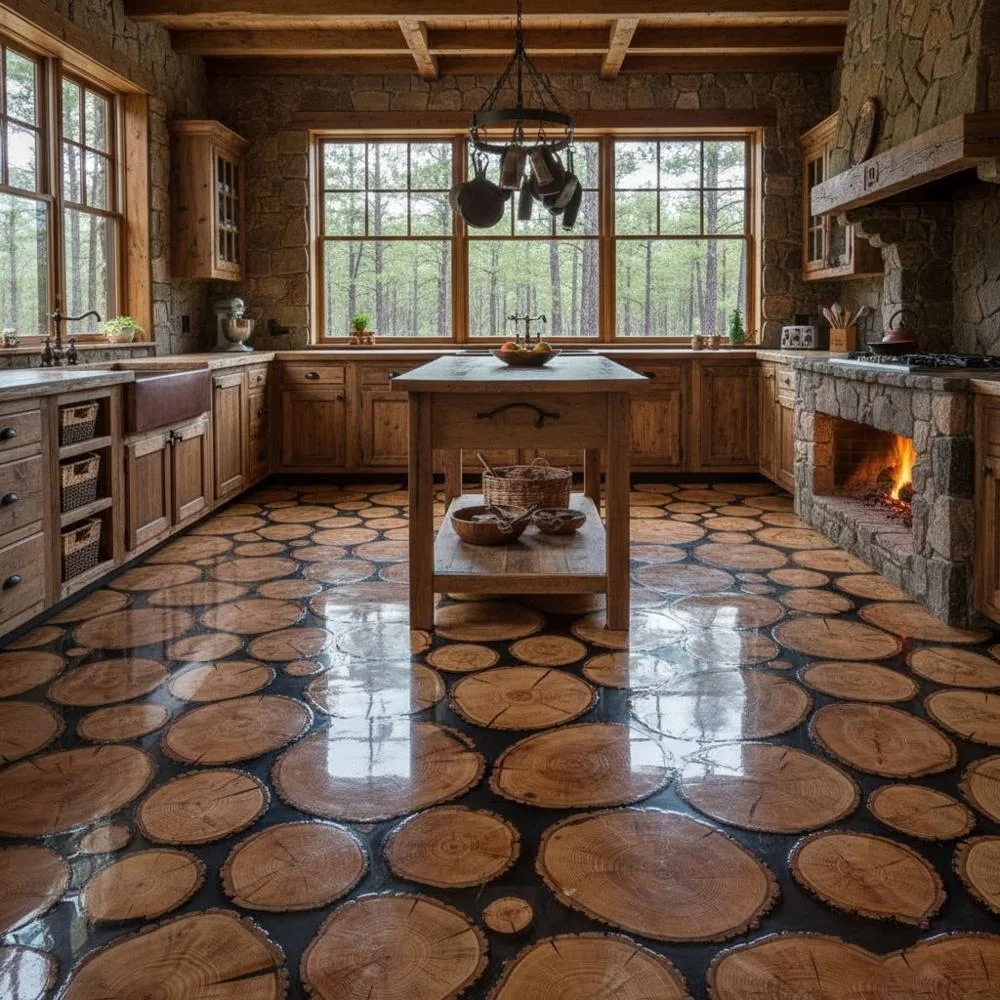
One major advantage of choosing a log epoxy floor is the relatively simple maintenance routine required to keep it looking beautiful. The epoxy coating creates a non-porous surface that resists staining and doesn’t trap dirt or debris. Regular sweeping or dust mopping removes surface particles, while damp mopping with pH neutral cleaners handles deeper cleaning needs.
Avoid using harsh chemicals, abrasive cleaners, or steam mops, as these can damage the epoxy finish over time. Acidic substances like vinegar or ammonia based products should never touch the surface. Instead, use cleaners specifically formulated for epoxy floors or simple solutions of mild dish soap and water.
Protecting Your Investment
Preventive care extends the life and beauty of your floor significantly. Place quality doormats at all entrances to capture dirt and grit before it reaches the floor. Use felt pads under furniture legs to prevent scratching when items are moved. For high traffic commercial applications, consider applying a sacrificial wax coating that can be periodically stripped and reapplied, protecting the underlying epoxy from wear.
Every five to ten years, depending on traffic levels, the floor may benefit from a light sanding and application of fresh clear epoxy coats. This process, often called recoating, refreshes the appearance and restores the protective layer without requiring complete removal and reinstallation.
Ideal Applications and Best Use Cases
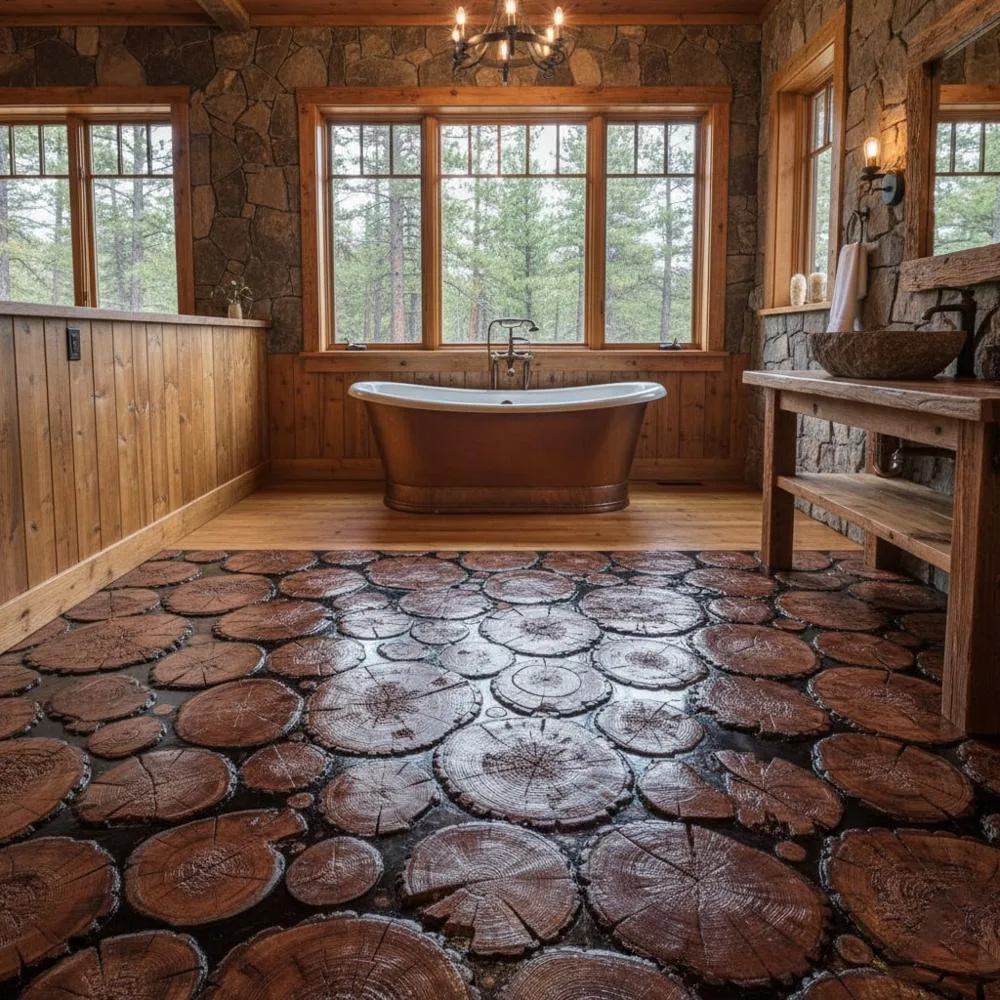
A log epoxy floor works beautifully in numerous residential and commercial settings. In homes, these floors create stunning focal points in living rooms, dining areas, and even bedrooms for those who want something truly unique. The natural aesthetic fits perfectly with log cabin interiors, rustic lodges, and mountain retreats, but the versatility of design also allows integration into modern or industrial spaces.
Commercial applications include retail stores wanting distinctive branding through their flooring, restaurants and bars creating memorable atmospheres, and office lobbies making strong first impressions. The durability of epoxy makes these floors suitable for moderate to heavy traffic areas when properly installed and maintained.
However, some locations are less ideal for log epoxy floors. Outdoor installations face challenges from temperature fluctuations and UV exposure that can cause epoxy yellowing or degradation. Spaces with heavy industrial equipment or frequent impacts may damage the surface despite epoxy’s toughness. Areas with significant moisture exposure require extra sealing precautions to prevent water from reaching the wood through any microscopic gaps.
Environmental Considerations and Sustainability

For environmentally conscious property owners, a log epoxy floor offers both benefits and considerations. On the positive side, using log slices makes efficient use of wood that might otherwise be waste material. Fallen trees, cleared branches, and salvaged lumber from demolished buildings all provide excellent source material. This approach embraces the concept of upcycling and reduces demand for newly harvested timber.
The durability and longevity of these floors also contribute to sustainability. A properly installed log epoxy floor can last for decades with appropriate care, eliminating the need for replacement flooring and reducing overall material consumption over time. The timeless aesthetic means the floor won’t look dated, encouraging property owners to keep it rather than renovating for style updates.
Epoxy resin itself presents environmental complexities. Traditional epoxies are petroleum based products with significant carbon footprints during manufacture. The installation process produces VOC emissions as the resin cures, though modern formulations have greatly reduced these concerns. Some manufacturers now offer bio-based epoxies derived from plant materials, providing more sustainable options for environmentally focused projects.
Comparing Alternatives and Making Your Decision

When considering a log epoxy floor, it helps to understand how it compares to alternative flooring options. Traditional hardwood flooring costs less initially but requires more maintenance and is more susceptible to water damage. Laminate or luxury vinyl planks offer wood aesthetics at lower prices but lack the authentic character and durability of real wood embedded in epoxy.
Polished concrete provides similar durability to epoxy but without the natural warmth of wood. Tile flooring is extremely durable and water resistant but can feel cold and hard underfoot. The unique combination of natural beauty and modern performance found in a log epoxy floor occupies a special niche that no single alternative can fully replicate.
Your decision should factor in your aesthetic preferences, budget constraints, intended use of the space, and willingness to invest in proper installation. For spaces where you want maximum visual impact, authentic natural materials, and long term durability, a log epoxy floor represents an excellent choice despite the higher initial investment.
Bringing Your Vision to Life
Creating a successful log epoxy floor starts with careful planning and clear vision. Begin by gathering inspiration from completed projects, noting what appeals to you about different wood species, patterns, and color combinations. Consider how the floor will interact with other design elements in your space, including wall colors, furniture styles, and lighting conditions.
Working with experienced professionals proves invaluable for most installations. Look for contractors with specific portfolios showing completed log epoxy projects rather than general epoxy coating experience alone. Ask detailed questions about their wood sourcing, drying processes, and warranty offerings. Quality installations come from craftspeople who understand both the artistic and technical aspects of this specialized flooring.
Wrapping It All Together: Your Path Forward with Log Epoxy Flooring
A log epoxy floor represents more than just a place to walk. It transforms ordinary spaces into extraordinary environments where natural beauty meets cutting edge performance. The combination of authentic wood character with the protection and durability of epoxy resin creates flooring that serves as both functional surface and artistic statement. While the investment of time and resources is substantial, the result is a completely unique floor that tells a story and creates lasting impressions for everyone who experiences it. Whether you’re building a new home, renovating existing space, or creating a memorable commercial environment, this innovative flooring solution deserves serious consideration for anyone seeking something truly special underfoot.

